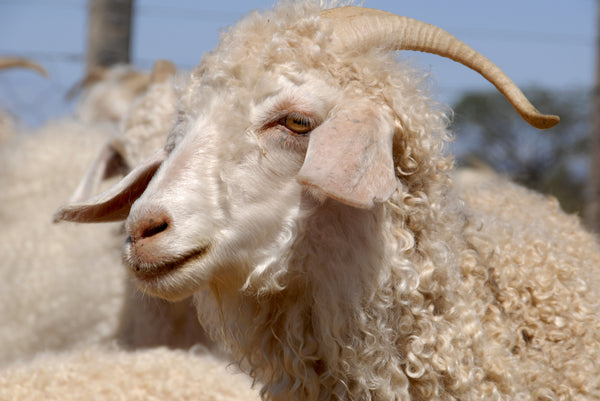Know Your Fiber: Mohair
Posted on November 01 2017

Let’s take a look at mohair! Mohair comes from Angora goats, and to look at their history, we have to go back to when humans first learned to keep goats as livestock.
Goats were among the first animals to be domesticated by humans; it is thought that goat domestication occurred during the Neolithic era. Neolithic farmers raised goats primarily for their meat, skins and milk. Based on archaeological evidence, the prevailing theory is that goat domestication likely first occurred in the hills below the Zagros Mountains, which run through Turkey, Iran and Iraq.
It is not certain when people started also breeding and using goats for their fiber. The first sculptural evidence of spinning we have is from over 20,000 years ago (a string skirt on a Paleolithic Venus), and Neolithic spindle whorls have been found around the world. It is perhaps not too much of a stretch to guess that goat fiber was used quite early in human history.
The earliest physical evidence of long-haired goat fiber being used was found among textiles excavated in Amarna, Egypt from 1400 BCE. Contrary to some assertions though, there is no evidence that this goat fiber was mohair. Likewise, there are also Biblical references to goat hair being used for curtains and tents, but again there is no evidence that the fiber referred to was mohair.
The actual origins of Angora goats are somewhat shrouded by the mists of history. By the first century, writings start to mention the distinctive long fiber of goats from Anatolia (Asia Minor). While this is not by any means definitive proof of the origin of Angora goats, it does provide a likely indicator that goats were starting to be bred in this part of the world for their long locks. It is entirely possible that these goats were the ancestors of modern Angora goats.
What we know for certain about Angora goats is that knowledge of their existence as we know them today initially reached Western Europe from Ankara, Turkey in 1555 in the writings of Father Belon. The word Angora comes from the city of Ankara and, true to Turkey’s Arabic heritage, the word mohair comes from the Arabic word, makhayer, which translates as preference, or chosen.
Although Angora goats began to be known in parts of Europe outside of Turkey from 1555 on, it wasn’t for another century that actual mohair fiber made its way to Western Europe. Once it arrived in the mid-1600s, the naturally curly mohair was initially used to make wigs.
As mohair started to gain popularity among Western Europe, Turkey responded by quickly putting a ban on any exports of mohair or Angora goats, with the exception of mohair spun into yarn and a few Angora goats given to heads of state as presents. This allowed Turkey to corner the market on this luxury fiber for quite some time. It wasn’t until 1820 that the first official raw mohair export to Western Europe arrived in England, as the ban on raw mohair exports from Turkey was lifted. Machinery was developed to spin these long fibers, and by 1839 the demand was such that more raw fiber than spun yarn was being exported from Turkey.
The demand for raw mohair meant that people from other countries started showing interest in raising Angora goats, as well. Between 1500 and 1800, sporadic attempts at raising Angora goats had been attempted outside of Turkey. However, those attempts had led to failure and the belief (perhaps encouraged by Turkey) that Angora goats could only be successfully raised in their native country. By 1848 South Africa and the United States of America were ready to prove to the world that Angora goats could be raised outside of Turkey, and by 1893 the mohair industry in South Africa was producing twice as much mohair as Turkey. The United States was less successful in raising Angora goats in Texas, but still contributed to the burgeoning world mohair trade. Seeing the successes in South Africa and the United States, Australia soon began to follow suit, as well as New Zealand.
Since the late 1800s and early 1900s, interest in mohair has both peaked and waned at various times, according to the vagaries of fashion. During the 1960s, mohair had a particularly strong surge in popularity when the fabric known at Tonik was developed in England. Thanks to mohair, this fabric had a sheen and color-shifting quality that made it a popular suiting fabric for mod culture during the 60s, and later in the 1970s to mid-1980s it also became popular among ska and Two Tone music aficionados.
Today, the majority of mohair on the world market comes from South Africa, with smaller amounts coming from Turkey, North America, Australia, New Zealand and other countries. The mohair in the yarns at our shop, such as the very popular Lamb’s Pride wool/mohair blend from Brown Sheep Company, come from farms around the world. However, our dyed and undyed loose mohair locks, found in the spinning/felting section of our shop, come from a local mohair farmer.
As a fiber, mohair has some characteristics that set it apart from other fibers. While similar to wool in some ways, mohair has a very smooth surface with very thin undeveloped scales. This means that mohair will not felt as wool does. The smoothness of the fiber causes yarns with mohair to have a wonderful sheen. Additionally, mohair is superior at taking up dye – it is possible to easily achieve rich, vibrant colors with mohair that can be more challenging to achieve in other natural fibers.
Traditionally, mohair from white Angora goats has been favored because of its ability to show off beautiful dyed colors, but here at Northwest Yarns we are starting to see an increased interest from spinners in the natural grays and light browns that are also available from Angora goats. The fiber itself is very elastic and strong. At between 25-45 microns in diameter, it is a thicker fiber, but one that is extremely smooth and lustrous. A little mohair can add quite a bit of character and sheen to your project.
Interested in checking out some mohair yarns and fibers, or have some more questions about the fiber? Come check out our shop in Bellingham, or visit us online. We look forward to seeing you there!

Follow US